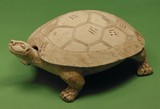
 |
Chinese (Han dynasty) Tortoise-Shaped Inkstone 206 B.C.-A.D. 220 Gray earthenware 4 inches high, 10 inches long William Hood Dunwoody Fund 32.54.4a,b |
An inkstone, by design, is a shallow, CONCAVE receptacle that stands on feet and is covered with a lid. In this case, the supports are the feet of the tortoise, and the shell serves as the lid. The inkstone tortoise is NATURALISTIC but at the same time fanciful. He stands solidly on the ground, ready to serve his purpose, all the while looking up and smiling with curiosity at the writer he serves. Inkstones vary in form and design from the sumptuous to the modest, and usually carry symbolic significance. For the Chinese, the tortoise represented long life, strength, and endurance.
The simple, solid form suggests that Han ceramics were greatly influenced by tomb sculptures made from stone. Indeed, the inkstone looks as if it were carved out of stone rather than modeled in soft clay. Although sculpture as an art form originated with the Han, larger sculpted works from this period have not survived. Han pottery figures, therefore, provide clues to this new tradition. The inkstone incorporates the major characteristics of a new style: bold outlines and simple forms, three-dimensional works to be viewed in the round, and a trend toward REALISM.3
On the shell, the artist incised a pattern of connected HEXAGONS. Eight of the hexagons contain three horizontal lines grouped one above the other, called TRIGRAMS. Each line is either continuous or broken in the middle. These lines can form eight possible trigrams, all of which are represented on the tortoise shell:
(TRIGRAMS SHOWN HERE)
The trigrams are combined in pairs to form sixty-four HEXAGRAMS. Each hexagram is explained in a Chinese book of wisdom called the I Ching, or Book of Change. The explanations are studied as a way toward self-cultivation and self-examination. The symbols of the I Ching are appropriate for an object used by Chinese scholars, who recorded the country's history and philosophy in writing. They regarded the eight trigrams as the forerunner of written characters.
Notes
3. Ezekiel Schloss, Art of the Han (New York: China Institute in America, 1979), pp. 13-14.

Key ideas.
Where does it come from?
What does it look like?
How was it used?
How was it made?
Discussion questions.
Additional resources.
Select another piece.